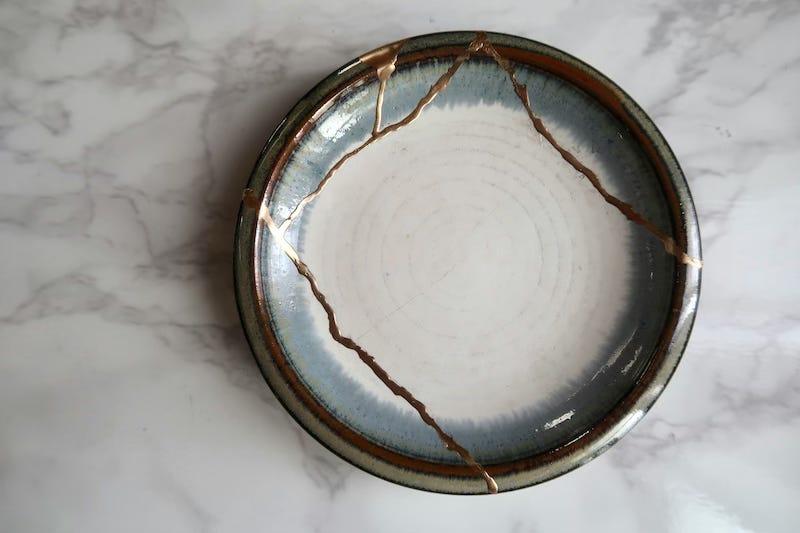Sometimes the search engine fails you.
Several years ago I was hired to write a series of seven articles about Resilience.
Whenever I Googled “Resilience” for images, the overwhelming majority of them were exactly the same.
It was always either a) someone pushing a boulder up a hill or b) a tiny weed breaking through a crack in the sidewalk.
Those, apparently, were the only ways anyone could think of to illustrate the concept.

As is often the case, my favorite angel cards came to the rescue.
Somehow, they’d found a unique and fresh spin, one that still eludes Google image search to this day.
What did the card depict for “Resilience?”
An angel bouncing on a trampoline, along with this message:
Take what comes in your stride and let your energy rebound.
Build positive momentum, elasticity, and endurance.
Show up with equanimity regardless of what is going on.

Recently, when I was (almost) hired to deliver a keynote presentation on a very similar topic — Adapting, again this month’s theme with Meditation HERE — I ran into the exact same image search problem.
The internet pretty much only offers one choice.
Specifically, the chameleon.
While accurate if perhaps a little obvious, I couldn’t help but wonder if a chameleon’s ability to change the color of its skin in order to blend in was really what adapting is all about.

Speaking of adapting…
Many of us remember purchasing vinyl LPs, 8-tracks, cassettes, CDs, downloads and now simply streaming the music we love.
There are treasured recordings I’ve probably owned in a half-dozen formats.
In direct contrast, however, is the classical sheet music I’ve purchased.
In a constantly evolving world, this has remained an almost perfect constant.
Starting piano in grade school, and after attaining a degree of skill years later, I began saving up to buy only Henle Verlag Urtext (“original text”) editions, the gold standard for publishing.
They are not only the most meticulous and scholarly versions, they are also extraordinarily elegant, with clear, beautiful typesetting.
Henle Verlag Urtext editions also have distinctive signature blue covers that make them instantly recognizable.
Every day, I still play from scores I’ve had for decades.
Beyond the delight of the music itself, in a world compulsively reinventing and re-marketing, I take great pleasure that here no upgrade is possible.

In a previous post I wrote that “the only casualty” of my recent move was the two-story maple tree I had to leave behind on my terrace.
That wasn’t quite true.
The movers had already departed, leaving an entirely empty space except for a final luggage cart of items I was taking in the rental car.
Heading for the parking garage, as Vlad and I rolled the cart into the elevator, a bizarre accident occurred.
As the wheels stumbled on the floor, a stack of last-minute papers I’d gathered shifted, and somehow one of my Urtext editions came loose.
Against all odds, it fell precisely through the narrow grate between the elevator and the floor, tumbling down the shaft.
Since I’d taken only the five volumes I was currently practicing with me, I quickly realized it was Chopin’s Nocturnes.
Webster’s defines a Nocturne as “a dreamy composition for the piano,” and in that bittersweet moment of departure, I could only think of it as “the dream that fell through the crack.”

It’s all too easy for dreams to slip away, not only if we’re careless but perhaps especially if we hold on to them too tightly.
I love the ways the Irish poet Billy Collins wants us to appreciate the playful mysteries of art.
Introduction to Poetry
I ask them to take a poem
and hold it up to the light
like a color slideor press an ear against its hive.
I say drop a mouse into a poem
and watch him probe his way out,or walk inside the poem’s room
and feel the walls for a light switch.
I want them to waterski
across the surface of a poem
waving at the author’s name on the shore.But all they want to do
is tie the poem to a chair with rope
and torture a confession out of it.They begin beating it with a hose
to find out what it really means.
There are many things in life that have to be held just right.
Too tight and you strangle them; too loose and — like those Nocturnes — they slip through your fingers towards oblivion.

Einstein probably never said it, but there’s great truth in the maxim:
“The definition of insanity
is doing the same thing over and over again
and expecting different results”
Adaptation is necessary (xecept maybe for Urtext editions).
I often think of my (sadly unsuccessful) late actor friend who was unable to take any feedback, any direction whatsoever, whether that was professional or personal.
A sweet guy, he prized perseverance above all other virtues.
This resulted in his being totally committed but never succeeding.
He was uncoachable, simply because he was unwilling to adapt.
If you, however, have a dream — one you’re striving neither to interrogate strapped to a chair nor to let slip through your fingers — maybe I can help.
I’m opening up a few coaching slots (both creative and life/reinvention) for this fall and you can apply for one HERE.
Rather than pushing a boulder up a hill — or growing through the sidewalk solo — maybe we could have fun bouncing on a trampoline together.

Here’s the truth about chameleons.
Their skin has layers of very specialized cells that, by expanding and contracting, shift both the pigments and the way light scatters on them.
Fun fact: some species (like the panther chameleon) can go from a dull green to neon turquoise, yellow, and red in seconds.
But here’s what’s even more significant.
The main reason they change color is actually NOT camouflage.
Instead, it’s about communication and thermoregulation.
In order to absorb more heat chameleons turn darker, and when they need to cool down they go lighter.
Perhaps more importantly, they use color to communicate.
Color signals mood, intentions, and status in the chameleon community.
Bright colors can indicate dominance or aggression, while dull colors might signal submission.
Yes, they’re adapting — but it’s far more creative than just blending in.

It’s not from the angel cards, but nonetheless I have landed on my own personal symbol for adaptation: Kintsugi pottery.
Kintsugi (金継ぎ, literally “gold joinery”) is the traditional Japanese art of repairing broken pottery with lacquer mixed with powdered gold, silver, or platinum.
In our culture, we’re often taught to hide flaws and mask damage.
Instead of hiding what’s broken, kintsugi highlights the cracks and repairs as part of the object’s history.
In a supremely great poetic irony, the new piece becomes more beautiful and more valuable than it was before it was broken.
This kind of adaptation is not about mere survival or blending in.
It’s not about pushing boulders up the hill or relying on camouflage.
It’s no longer a cliché stock image but rather a metaphor for deep transformation.
It’s about filling our broken spaces with gold… and letting them shine.
Tell A New Story | Transform Your Life

